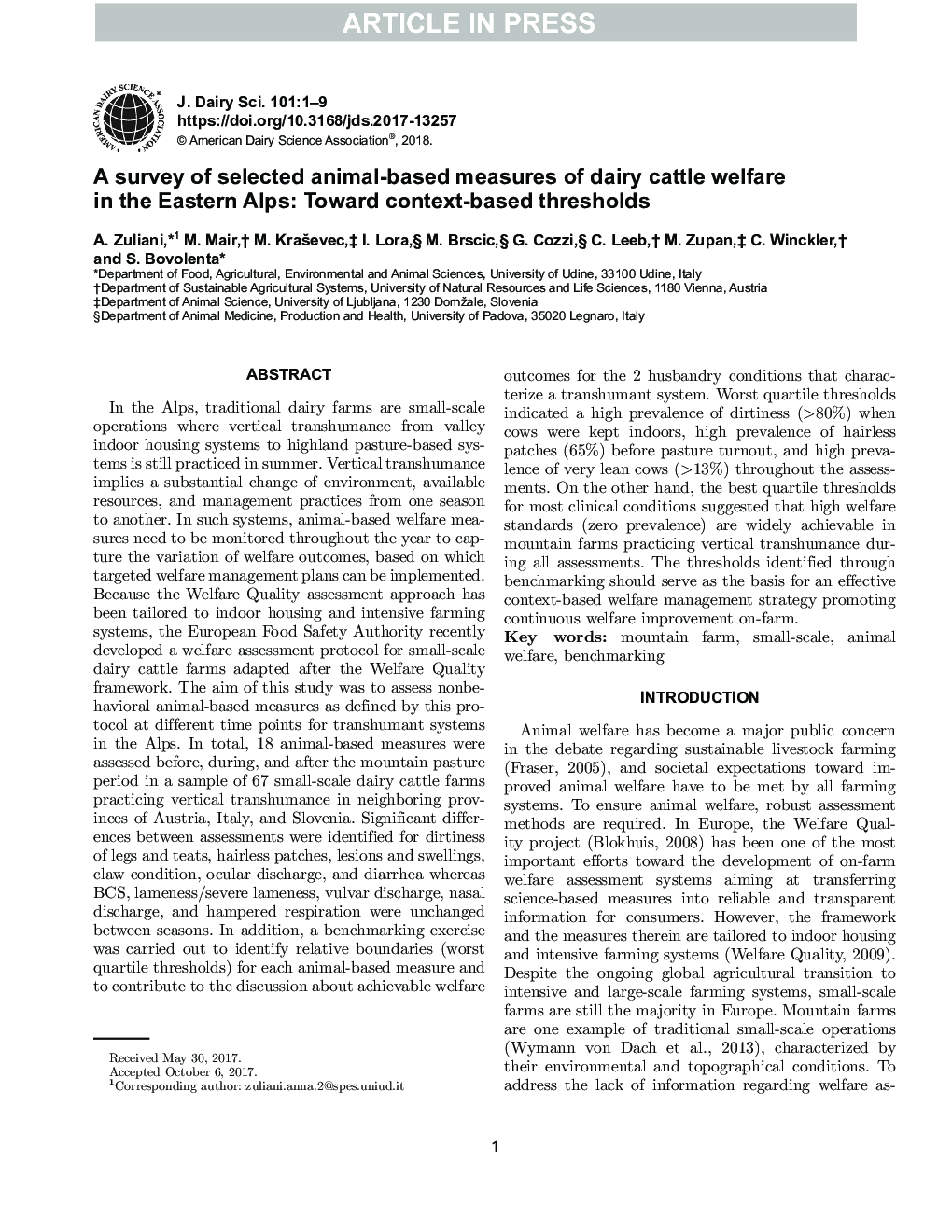| کد مقاله | کد نشریه | سال انتشار | مقاله انگلیسی | نسخه تمام متن |
|---|---|---|---|---|
| 8501652 | 1553843 | 2018 | 9 صفحه PDF | دانلود رایگان |
عنوان انگلیسی مقاله ISI
A survey of selected animal-based measures of dairy cattle welfare in the Eastern Alps: Toward context-based thresholds
ترجمه فارسی عنوان
یک نظرسنجی از شاخص های انتخاب شده حیوانات رفاه گاوهای شیری در مناطق آلپ شرقی: به سمت آستانه های مبتنی بر زمینه
دانلود مقاله + سفارش ترجمه
دانلود مقاله ISI انگلیسی
رایگان برای ایرانیان
کلمات کلیدی
مزرعه کوه، مقیاس کوچک، رفاه حیوانات، معیار سنجش،
موضوعات مرتبط
علوم زیستی و بیوفناوری
علوم کشاورزی و بیولوژیک
علوم دامی و جانورشناسی
چکیده انگلیسی
In the Alps, traditional dairy farms are small-scale operations where vertical transhumance from valley indoor housing systems to highland pasture-based systems is still practiced in summer. Vertical transhumance implies a substantial change of environment, available resources, and management practices from one season to another. In such systems, animal-based welfare measures need to be monitored throughout the year to capture the variation of welfare outcomes, based on which targeted welfare management plans can be implemented. Because the Welfare Quality assessment approach has been tailored to indoor housing and intensive farming systems, the European Food Safety Authority recently developed a welfare assessment protocol for small-scale dairy cattle farms adapted after the Welfare Quality framework. The aim of this study was to assess nonbehavioral animal-based measures as defined by this protocol at different time points for transhumant systems in the Alps. In total, 18 animal-based measures were assessed before, during, and after the mountain pasture period in a sample of 67 small-scale dairy cattle farms practicing vertical transhumance in neighboring provinces of Austria, Italy, and Slovenia. Significant differences between assessments were identified for dirtiness of legs and teats, hairless patches, lesions and swellings, claw condition, ocular discharge, and diarrhea whereas BCS, lameness/severe lameness, vulvar discharge, nasal discharge, and hampered respiration were unchanged between seasons. In addition, a benchmarking exercise was carried out to identify relative boundaries (worst quartile thresholds) for each animal-based measure and to contribute to the discussion about achievable welfare outcomes for the 2 husbandry conditions that characterize a transhumant system. Worst quartile thresholds indicated a high prevalence of dirtiness (>80%) when cows were kept indoors, high prevalence of hairless patches (65%) before pasture turnout, and high prevalence of very lean cows (>13%) throughout the assessments. On the other hand, the best quartile thresholds for most clinical conditions suggested that high welfare standards (zero prevalence) are widely achievable in mountain farms practicing vertical transhumance during all assessments. The thresholds identified through benchmarking should serve as the basis for an effective context-based welfare management strategy promoting continuous welfare improvement on-farm.
ناشر
Database: Elsevier - ScienceDirect (ساینس دایرکت)
Journal: Journal of Dairy Science - Volume 101, Issue 2, February 2018, Pages 1428-1436
Journal: Journal of Dairy Science - Volume 101, Issue 2, February 2018, Pages 1428-1436
نویسندگان
A. Zuliani, M. Mair, M. Kraševec, I. Lora, M. Brscic, G. Cozzi, C. Leeb, M. Zupan, C. Winckler, S. Bovolenta,
